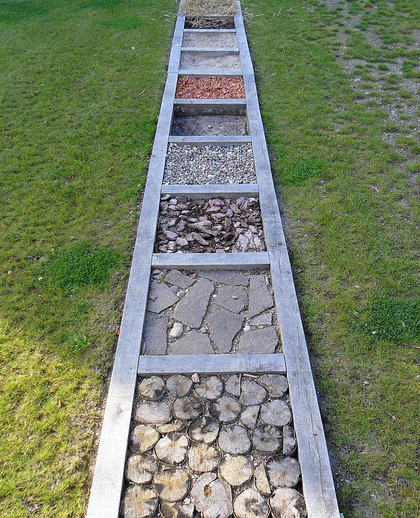
Continuing my musings on this idea of play-as-path and path-as-play…there is no better example of this in the ‘natural play’ arena than the barefoot park. Having led the way in the development of the natural playground, the European countries–particularly Germany and Austria–have moved on to advocate that natural elements and surfaces be accessible to the unshod foot; installing several hundred ‘barefoot parks’ over the last decade.
The basic idea is to provide a place for shoe-keeping (at the beginning) and foot-washing (at the end) and a series of activities–from walking a tightrope and balancing on a log to wading through water or mud and stepping through wood shavings or pinecones–that provide different sensations. Because the basic activity is simply walking, these are intergenerational playspaces, suitable for feet of all ages! In large landscapes the sensations might be episodes along a hiking trail (play-as-path again!), integrated with features like balance beams and climbers that strongly overlap with familiar natural playground elements. But in smaller locations you can simply install a ’sensation path’ .
Sensation paths can easily be worked into any public playscape, and most backyards. You’re simply creating a bounded pathway, with sections of changing surface materials. Think mulch, then sand, then cobbles then bricks. In a woodland area, the sections might be bounded by logs and intersected with a stump balance beam. In your own backyard, you could simply alternate mulch and sand and pea gravel, plus a small piece of decking either elevated as a bridge or simply set flush with the ground. An optional handrail both helps balance and adds extra play value.
In a more formal or high-use setting, a sensation pathway can be edged with brick or stone and the differing materials set into concrete for durability; this is the case for most Asian sensation paths, which are strongly tied to their tradition of reflexology and are common even in urban settings. But in any setting, the sensation path can continue up stairs or down slopes, and wind through existing features like sand or water play areas.
Most public playgrounds have some sort of a path anyway, why not make it a sensation pathway? When you design a playspace, never plan a feature–even a mundane one–without asking yourself if it can be made playable. Sometimes, when sensation pathways are designed for children, they’re called ‘tickle paths’. Add some tall tickly grasses as a border, and you’re there.
For more, see the helpful site barfusspark, which has a directory of barefoot parks throughout Europe, a design guide for barefoot parks (mostly inspirational photos), sensation path instructions, and a section with thoughts on playground equipment for the barefoot park. All images are via barfusspark. See also a nice account of a barfusspark visit at the blog yencamade. More info on the exemplary sensation pathway at Trentham, Staffordshire in tomorrow’s post!
The post Barefoot Parks and Sensation Paths appeared first on Playscapes.